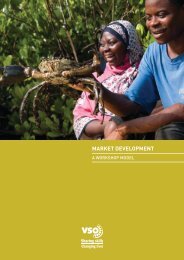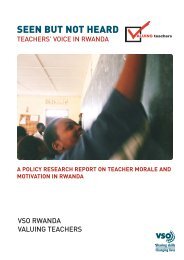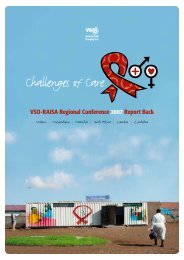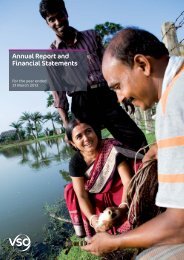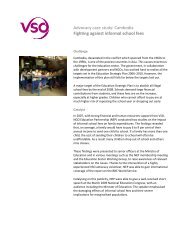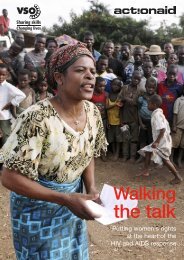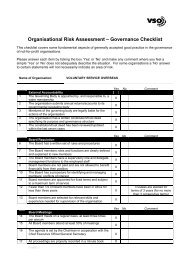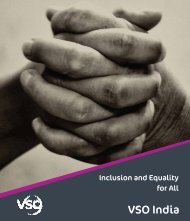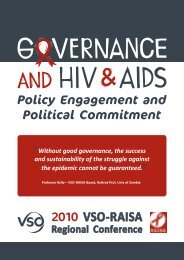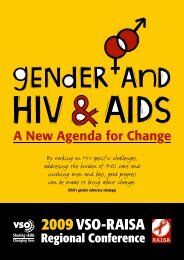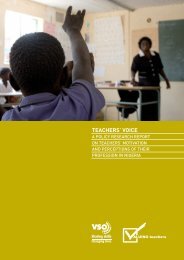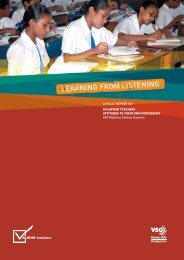Teachers for All â GCE policy briefing (566KB) - VSO
Teachers for All â GCE policy briefing (566KB) - VSO
Teachers for All â GCE policy briefing (566KB) - VSO
You also want an ePaper? Increase the reach of your titles
YUMPU automatically turns print PDFs into web optimized ePapers that Google loves.
Disability<strong>Teachers</strong> play a crucial role in modelling inclusive attitudes and establishing expectations in theclassroom. As such, disabled teachers – as well as able bodied teachers that are sensitised todisability issues – can be instrumental in combating discrimination and promoting positiveidentities in disabled children, and in breaking down prejudices of non-disabled children. Disabledteachers in particular can provide positive examples <strong>for</strong> parents of disabled children, who may feelthat there is little point in sending their disabled child to school, because of the stigma anddiscrimination related to disability.Statistics on both the numbers of teachers being trained in inclusive practices and child-centredpedagogy, and the numbers of disabled teachers in developing countries, are very hard to obtain. Inthe absence of these statistics, we can only infer the current situation based on the evidenceavailable.We can assume that the number of disabled people who are teachers is very low, given the body ofevidence that suggests that disabled people are more likely than non-disabled people to experiencedisadvantage, exclusion and discrimination in the labour market (ILO, 2004). In Cambodia, <strong>for</strong>example, the current Ministry of Education practice is to exclude disabled people from training tobe teachers, and to remove teachers who become disabled from active classroom teaching toadministrative roles (Thomas, 2005). Moreover, the lack of educational opportunities available todisabled children means that there is a very limited pool of disabled men and women who meet theminimum qualification standards to enable them to apply to train as teachers, even wherelegislation and opportunities allow them to. Particularly <strong>for</strong> deaf children, teachers able to usenatural sign language are essential. Encouraging deaf people to become teachers, and otherteachers with deaf children in their classes to learn sign language, should there<strong>for</strong>e be a highpriority <strong>for</strong> governments whose duty it is to provide a quality education to all children – includingdeaf children.Indeed, more broadly, it is clear that all countries should ensure that discrimination againstdisabled people in the teaching profession is effectively prohibited and legislated against.Governments should also put in place systems, procedures and strategies to enable them actively torecruit, train and retain disabled people as teachers.EthnicityIn many countries, ethnic minority groups live in the remotest and poorest areas, which tend to bethe areas worst served by education systems. There are fewer schools and teachers due toresourcing and recruitment problems, and children face long distances between home and school.Perhaps the biggest barrier to education <strong>for</strong> children from ethnic minorities is that they may notunderstand the language used as the medium of instruction. This is because government policieseither actively or passively promote the national language in schools, and because not enoughpeople who speak ethnic minority languages are able to become teachers – often because membersof ethnic minority communities have limited access to education in the first place. Inflexiblydesigned curricula, which have no link to the lives of ethnic minority children, can also makeeducation appear irrelevant to ethnic minority parents and communities.One such example is Laos. Until recently, government and donors focused on quantitativeexpansion of qualified teachers and schools. Except <strong>for</strong> some provision of scholarships toencourage ethnic minority adults to become teachers, there were limited ef<strong>for</strong>ts to target moredisadvantaged areas, with many donors favouring only large settlements <strong>for</strong> construction grants.There<strong>for</strong>e, while some degree of schooling is now in the reach of many more children,improvements have reached the urban and ‘better off’ areas first and disproportionately.Meanwhile, the poorest and most remote places have been the last to be served. Up to 70% ofteachers in mountainous districts are unqualified and have particularly low levels of education.Overall, 80% of teachers are from the majority Lao ethnic group, but <strong>for</strong> almost 40% of children,the language of the school is not the language of home. The curriculum too, is focused on urbanand ethnic Lao children, and does not cater to the needs and aspirations of ethnic minority23



